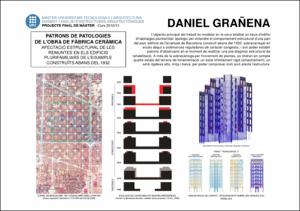Mostra el registre d'ítem simple
Patrons de patologies de l'obra de fàbrica cerámica: afectació estructural de les remuntes en els edificis plurifamiliars de l’Eixample construïts abans del 1932
| dc.contributor | Garcia Carrera, David |
| dc.contributor | Payola Lahoz, Jordi |
| dc.contributor.author | Grañena Pelegrín, Daniel |
| dc.contributor.other | Universitat Politècnica de Catalunya. Departament d'Enginyeria de la Construcció |
| dc.contributor.other | Universitat Politècnica de Catalunya. Departament d'Estructures a l'Arquitectura |
| dc.contributor.other | Universitat Politècnica de Catalunya. Departament de Construccions Arquitectòniques I |
| dc.coverage.spatial | east=2.164196899999979; north=41.391843; name=La Dreta de l'Eixample, Barcelona, Espanya |
| dc.date.accessioned | 2014-06-05T15:32:37Z |
| dc.date.available | 2014-06-05T15:32:37Z |
| dc.date.issued | 2013-09 |
| dc.identifier.uri | http://hdl.handle.net/2099.1/21695 |
| dc.description.abstract | El perfil edificat de l’Eixample de Cerdà mai fou dut a terme. En el seu lloc, es decidí densificar la nova ciutat per qüestions econòmiques d’inversió de capital. Si bé en un primer moment va haver certa contenció, durant el temps de la dictadura, el perfil de la ciutat va créixer implicant la seva densificació i la imatge de la ciutat en certs llocs obscena, estèticament parlant. En el moment en què es va permetre créixer sobre edificis existents augmentant el nombre de plantes, segons les ordenances vigents del moment, hom es planteja quina és l’afectació d’aquestes preexistències, ja no pel que fa a la seva imatge, si no en relació a l’estat sobrecarregat de la seva estructura, que prèviament no contemplava aquelles plantes de més. Actualment, la necessitat de rehabilitar edificis a Catalunya, degut a diversos factors com la llarga crisis econòmica del món d ela construcció, l’envelliment del parc edificat, la seva manca de manteniment o la recent conscienciació de la societat sobre aspectes de sostenibilitat, és més present que mai, i cal doncs reivindicar la rehabilitació del nostre patrimoni edificat, en vers la postura antagònica que seria enderrocar per tornar a construir. Així doncs, aquesta tesina d’arquitectura, pretén establir, des del punt de vista de rehabilitació de l’obra de fàbrica, patrons de possibles patologies estructurals sobre un cas concret d’edificis de l’Eixample de Barcelona: els edificis plurifamiliars construïts abans de 1932 (tots ells amb el mateix sistema constructiu) que han sofert remuntes posteriors durant la seva llarga vida útil. |
| dc.description.abstract | The city’s profile of Cerda’s Eixample design was never completed. Instead, it was decided to give shape to the new city for economic capital investment reasons. While at first was some contention, during the time of the dictatorship, the profile of the city grew implying a higher densification, and an image of the city in certain places obscene, aesthetically speaking. At the time it was allowed to re-grow the existing buildings on increasing the number of plants, according to the regulations in force at the time, one thinks about the involvement of these pre-existing buildings, not only in terms of its image, but in relation to its overloaded structure, which previously wasn’t planned with that height increase. Currently, the need to rehabilitate buildings in Catalonia, due to several factors such as the long economic crisis in the world of construction, aging building stock, the lack of maintenance and the recent awareness in society about sustainability issues is more present than ever, and we must therefore demand the restoration of our built heritage, in what would be an antagonistic stance towards down for a rebuild. Thus, this architectural dissertation aims to establish, from the point of view of rehabilitation of masonry, structural patterns of possible pathologies on a specific case of buildings of the Eixample district of Barcelona: the apartment buildings built before 1932 (all with the same construction system) that have suffered the addition of several new floors during his long life. |
| dc.language.iso | cat |
| dc.publisher | Universitat Politècnica de Catalunya |
| dc.rights | Attribution-NonCommercial-ShareAlike 3.0 Spain |
| dc.rights.uri | http://creativecommons.org/licenses/by-nc-sa/3.0/es/ |
| dc.subject | Àrees temàtiques de la UPC::Arquitectura::Tipologies d'edificis::Habitatges |
| dc.subject.lcsh | Apartment houses -- Spain -- Eixample (Barcelona) |
| dc.subject.lcsh | Building, Brick |
| dc.subject.lcsh | Building failures |
| dc.subject.lcsh | Buildings -- Additions |
| dc.subject.other | Remuntes |
| dc.subject.other | Obra de fàbrica ceràmica |
| dc.subject.other | Patrons de patologies |
| dc.subject.other | Tensions |
| dc.subject.other | Creus de tensions principals |
| dc.subject.other | Assentament diferencial |
| dc.subject.other | Macromodelització |
| dc.subject.other | Re-grown buildings |
| dc.subject.other | Ceramic masonry |
| dc.subject.other | Eixample |
| dc.subject.other | Barcelona |
| dc.subject.other | Pathology patterns |
| dc.subject.other | Stresses |
| dc.subject.other | Main stress crosses |
| dc.subject.other | Differential settlement |
| dc.subject.other | Macromodelization |
| dc.title | Patrons de patologies de l'obra de fàbrica cerámica: afectació estructural de les remuntes en els edificis plurifamiliars de l’Eixample construïts abans del 1932 |
| dc.title.alternative | Pathology patterns of ceramic masonry: structural involvement of re-grown Eixample’s apartment buildings built before 1932 |
| dc.type | Master thesis |
| dc.subject.lemac | Cases de pisos -- Catalunya -- Eixample (Barcelona: Barri) |
| dc.subject.lemac | Construcció en maó |
| dc.subject.lemac | Construcció -- Patologia |
| dc.subject.lemac | Edificis -- Ampliacions |
| dc.rights.access | Open Access |
| dc.audience.educationlevel | Màster |
| dc.audience.mediator | Escola Tècnica Superior d'Arquitectura de Barcelona |
| dc.audience.mediator | Escola Tècnica Superior d'Arquitectura del Vallès |
| dc.audience.degree | MÀSTER UNIVERSITARI EN TECNOLOGIA A L'ARQUITECTURA (Pla 2009) |



